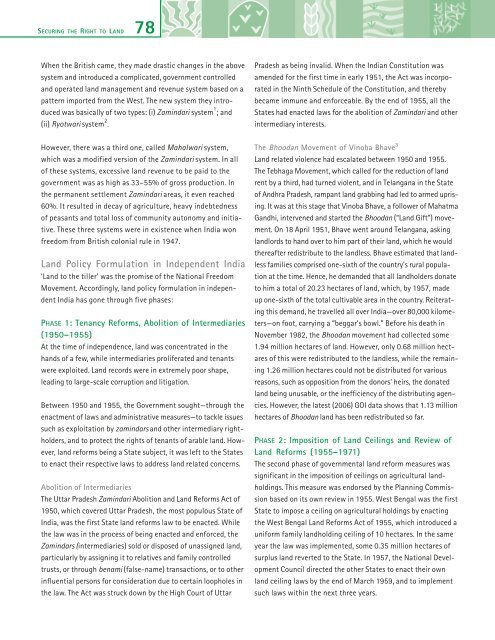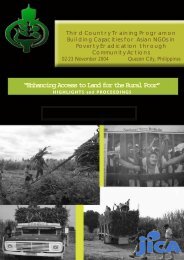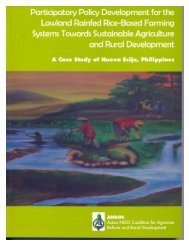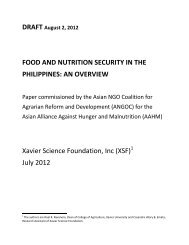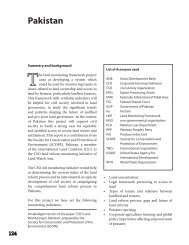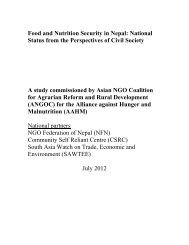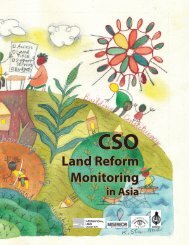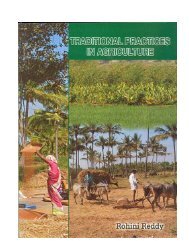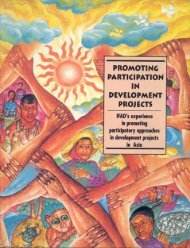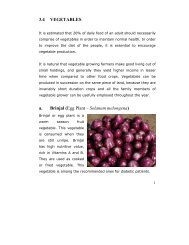Securing the Right to Land FULL - ANGOC
Securing the Right to Land FULL - ANGOC
Securing the Right to Land FULL - ANGOC
You also want an ePaper? Increase the reach of your titles
YUMPU automatically turns print PDFs into web optimized ePapers that Google loves.
SECURING THE RIGHT TO LAND<br />
78<br />
When <strong>the</strong> British came, <strong>the</strong>y made drastic changes in <strong>the</strong> above<br />
system and introduced a complicated, government controlled<br />
and operated land management and revenue system based on a<br />
pattern imported from <strong>the</strong> West. The new system <strong>the</strong>y introduced<br />
was basically of two types: (i) Zamindari system 1 ; and<br />
(ii) Ryotwari system 2 .<br />
However, <strong>the</strong>re was a third one, called Mahalwari system,<br />
which was a modified version of <strong>the</strong> Zamindari system. In all<br />
of <strong>the</strong>se systems, excessive land revenue <strong>to</strong> be paid <strong>to</strong> <strong>the</strong><br />
government was as high as 33–55% of gross production. In<br />
<strong>the</strong> permanent settlement Zamindari areas, it even reached<br />
60%. It resulted in decay of agriculture, heavy indebtedness<br />
of peasants and <strong>to</strong>tal loss of community au<strong>to</strong>nomy and initiative.<br />
These three systems were in existence when India won<br />
freedom from British colonial rule in 1947.<br />
<strong>Land</strong> Policy Formulation in Independent India<br />
‘<strong>Land</strong> <strong>to</strong> <strong>the</strong> tiller’ was <strong>the</strong> promise of <strong>the</strong> National Freedom<br />
Movement. Accordingly, land policy formulation in independent<br />
India has gone through five phases:<br />
PHASE 1: Tenancy Reforms, Abolition of Intermediaries<br />
(1950–1955)<br />
At <strong>the</strong> time of independence, land was concentrated in <strong>the</strong><br />
hands of a few, while intermediaries proliferated and tenants<br />
were exploited. <strong>Land</strong> records were in extremely poor shape,<br />
leading <strong>to</strong> large-scale corruption and litigation.<br />
Between 1950 and 1955, <strong>the</strong> Government sought—through <strong>the</strong><br />
enactment of laws and administrative measures—<strong>to</strong> tackle issues<br />
such as exploitation by zamindars and o<strong>the</strong>r intermediary rightholders,<br />
and <strong>to</strong> protect <strong>the</strong> rights of tenants of arable land. However,<br />
land reforms being a State subject, it was left <strong>to</strong> <strong>the</strong> States<br />
<strong>to</strong> enact <strong>the</strong>ir respective laws <strong>to</strong> address land related concerns.<br />
Abolition of Intermediaries<br />
The Uttar Pradesh Zamindari Abolition and <strong>Land</strong> Reforms Act of<br />
1950, which covered Uttar Pradesh, <strong>the</strong> most populous State of<br />
India, was <strong>the</strong> first State land reforms law <strong>to</strong> be enacted. While<br />
<strong>the</strong> law was in <strong>the</strong> process of being enacted and enforced, <strong>the</strong><br />
Zamindars (intermediaries) sold or disposed of unassigned land,<br />
particularly by assigning it <strong>to</strong> relatives and family controlled<br />
trusts, or through benami (false-name) transactions, or <strong>to</strong> o<strong>the</strong>r<br />
influential persons for consideration due <strong>to</strong> certain loopholes in<br />
<strong>the</strong> law. The Act was struck down by <strong>the</strong> High Court of Uttar<br />
Pradesh as being invalid. When <strong>the</strong> Indian Constitution was<br />
amended for <strong>the</strong> first time in early 1951, <strong>the</strong> Act was incorporated<br />
in <strong>the</strong> Ninth Schedule of <strong>the</strong> Constitution, and <strong>the</strong>reby<br />
became immune and enforceable. By <strong>the</strong> end of 1955, all <strong>the</strong><br />
States had enacted laws for <strong>the</strong> abolition of Zamindari and o<strong>the</strong>r<br />
intermediary interests.<br />
The Bhoodan Movement of Vinoba Bhave 3<br />
<strong>Land</strong> related violence had escalated between 1950 and 1955.<br />
The Tebhaga Movement, which called for <strong>the</strong> reduction of land<br />
rent by a third, had turned violent, and in Telangana in <strong>the</strong> State<br />
of Andhra Pradesh, rampant land grabbing had led <strong>to</strong> armed uprising.<br />
It was at this stage that Vinoba Bhave, a follower of Mahatma<br />
Gandhi, intervened and started <strong>the</strong> Bhoodan (“<strong>Land</strong> Gift”) movement.<br />
On 18 April 1951, Bhave went around Telangana, asking<br />
landlords <strong>to</strong> hand over <strong>to</strong> him part of <strong>the</strong>ir land, which he would<br />
<strong>the</strong>reafter redistribute <strong>to</strong> <strong>the</strong> landless. Bhave estimated that landless<br />
families comprised one-sixth of <strong>the</strong> country’s rural population<br />
at <strong>the</strong> time. Hence, he demanded that all landholders donate<br />
<strong>to</strong> him a <strong>to</strong>tal of 20.23 hectares of land, which, by 1957, made<br />
up one-sixth of <strong>the</strong> <strong>to</strong>tal cultivable area in <strong>the</strong> country. Reiterating<br />
this demand, he travelled all over India—over 80,000 kilometers—on<br />
foot, carrying a “beggar’s bowl.” Before his death in<br />
November 1982, <strong>the</strong> Bhoodan movement had collected some<br />
1.94 million hectares of land. However, only 0.68 million hectares<br />
of this were redistributed <strong>to</strong> <strong>the</strong> landless, while <strong>the</strong> remaining<br />
1.26 million hectares could not be distributed for various<br />
reasons, such as opposition from <strong>the</strong> donors’ heirs, <strong>the</strong> donated<br />
land being unusable, or <strong>the</strong> inefficiency of <strong>the</strong> distributing agencies.<br />
However, <strong>the</strong> latest (2006) GOI data shows that 1.13 million<br />
hectares of Bhoodan land has been redistributed so far.<br />
PHASE 2: Imposition of <strong>Land</strong> Ceilings and Review of<br />
<strong>Land</strong> Reforms (1955–1971)<br />
The second phase of governmental land reform measures was<br />
significant in <strong>the</strong> imposition of ceilings on agricultural landholdings.<br />
This measure was endorsed by <strong>the</strong> Planning Commission<br />
based on its own review in 1955. West Bengal was <strong>the</strong> first<br />
State <strong>to</strong> impose a ceiling on agricultural holdings by enacting<br />
<strong>the</strong> West Bengal <strong>Land</strong> Reforms Act of 1955, which introduced a<br />
uniform family landholding ceiling of 10 hectares. In <strong>the</strong> same<br />
year <strong>the</strong> law was implemented, some 0.35 million hectares of<br />
surplus land reverted <strong>to</strong> <strong>the</strong> State. In 1957, <strong>the</strong> National Development<br />
Council directed <strong>the</strong> o<strong>the</strong>r States <strong>to</strong> enact <strong>the</strong>ir own<br />
land ceiling laws by <strong>the</strong> end of March 1959, and <strong>to</strong> implement<br />
such laws within <strong>the</strong> next three years.


